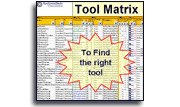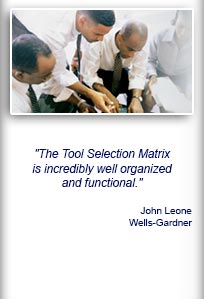Installation and Setup
Installation - Each User. Installation - Multi-user. Language Translations. Personalize Your Templates.Systems2win Training.
Quick Start Initial Training. New User Training. Training Matrix. Systems2win Leadership. Training Classes.Lean Training
Lean Training and Coaching. Lean Principles. Muda 8 Wastes. Goal - Lean Flow. Roadmap - Lean Journey. Value Stream Mapping. Standard Work. Hansei Lean Thinking. Lean Dictionary. Online Lean Training. Lean Leadership.Microsoft Office Training
Excel Training. Excel Drawings (without Visio). Excel Charts. Word Training. PDF Training. Document Storage and Naming.Support
Support.DMAIC Tools
DMAIC templates for the DMAIC process for quality improvement
It is not uncommon to hear the question:
Do you have a DMAIC Tool?
And the correct answer is:
"There is no such thing as a DMAIC Tool."

150+ DMAIC templates
There is the DMAIC Process,
and there are (literally) hundreds of quality improvement tools, lean tools, DFSS tools, and other process improvement tools that are each useful in different circumstances in each of the 5 phases of the DMAIC process.
The DMAIC Process
The Lean Six Sigma DMAIC process is a scientific method for process improvement
(similar to PDCA)
Define problems, customer wants, processes, and project boundaries.
Measure the process as it was, as it is, and as you want it to be.
Analyze sources of variation, performance gaps, and priorities to improve.
Improve the process by designing & implementing creative ways to fix and prevent problems.
Control the improved process — and prevent backsliding into old habits.
DMADV
In Design for Six Sigma, the process is similar, but a little different
Define problems, customer wants, processes, and project boundaries.
Measure the process as it was, as it is, and as you want it to be.
Analyze sources of variation, performance gaps, and priorities.
Design the product or process.
Verify that the design accomplishes the objectives.
When and Why to use
the DMAIC Methodology
DMAIC tools were never intended to be used in isolation

Every lean tool needs
a corresponding
Lean Coaching System
You will get a lot more from any Lean Six Sigma tool
when it is used within a framework that consists of:
- Leadership that inspires a lean culture
- Lean Management Systems
- Lean Systems for continuous improvement
- Lean Training
- Process Improvement Tools
When to choose the DMAIC Methodology
There are lots of problem solving tools and methods to choose from.
The DMAIC process is the right choice when:
- The problem that you're trying to solve is related to an issue with Quality
- It's an operational problem (not a design problem)
- Your boss doesn't have some other problem solving method that he or she prefers to use

How to use your
DMAIC templates
This training section provides a roadmap of the DMAIC process,
with special emphasis on which templates might prove most useful for each of the DMAIC phases.
Before getting started
We are assuming that you already completed the foundational Quick Start Training
so that you know how to find and open your templates,
and you know how to find help and training for every one of your 150+ templates.
DMAIC Phase 1)
Define
Define problems, customer wants, processes, and boundaries
Tools to consider using for this first phase might include:

Team Charter
Most commonly, you will use your Team Charter template (TeamCharter.xlsx)
but for some types of teams, some leaders prefer:
SIPOC (SIPOC.xlsx)
A3 Report (A3Report.docx)
Team Leadership templates
When you download your free trials,
you also receive leadership templates to launch any team
that you can use for the rest of your career (as a free gift)
Voice of the Customer templates
You have an entire suite of Voice of the Customer templates to make it easier to:

- Gather data from your customer listening posts
- Interpret it consistently
- Translate customer comments into engineering specifications
- Perform Kano Analysis
- Maybe use your Cause & Effect Matrix
- Maybe do a (very) thorough QFD House of Quality
Lean Management Systems
One of the primary purposes of Lean Management Systems is to make really obvious what is normal, and what is (at the moment) abnormal (and therefor needing management attention)

DMAIC Phase 2)
Measure
Most of the tools specified above to Define the problem also have features to collect and measure relevant data.
There are literally hundreds of additional tools to measure processes in different ways.
Some of the most popular include:

- Process Observation Time Study tools
- Layout Diagram
- Trend Analysis / Run Chart
- SPC Statistical Process Control Chart
- Basic Quality Tools
DMAIC Phase 3)
Analyze
Most of the tools specified above for Measure also have features to Analyze the data that you collected.
Some of the most popular tools for process analysis include:

Why is flow so important?
Process Flow
Lean (not six sigma) is particularly focused on optimizing flow
- Value Stream Map (for flow between processes)
- Cross Functional Flowchart (for flow within processes)
- Other types of flowcharts (for many other types of flow)
- Product Family Matrix
DMAIC Phase 4)
Improve
The primary tool used to improve a process is the human mind.
There is no substitute for Hansei questions to stimulate Lean Thinking.
Some tools that are particularly effective to stimulate and guide human thinking include:

The right DMAIC tools
to Define, Measure, Analyze, Improve, and Control
the quality of ANY process
DMAIC Phase 5)
Control
By far the most important tools for control are your Standard Work tools.

Who needs standard work?
Additional tools that are also useful for control include:
- Project Management tools
- Control Plan
- Corrective Action Plan
- Tools and systems for Training your people to do all these new things
- Lean Management Systems
Own all of these DMAIC templates
to empower every team member

Can't you just create a few tools in your free time?

How much free time
do you have?
to re-invent and support
home-made tools?
Download Free Trial
If your organization has
not yet provided a license,
download your free trial now
Training and Coaching
Consider Training and Coaching to support your teams to succeed

Training to get you started.
Tools you won't outgrow.
Schedule a Conference
Schedule a conference
to discuss your challenges
with an experienced lean advisor
Download Trial Now
Get a dozen trial templates,
and another dozen free gifts
@@@ Better conversion rate
if call to action is for a specific tool, and shows the image

Try It
Try this template
along with a couple dozen more
process improvement tools
Calls to Action Botttom
Related Topics
Related Topics section WITHOUT TESTIMONIALS
Replace this paragraph with menu library item for topics related to this video
Training and Coaching
Consider Training and Coaching to support your teams to succeed

Training to get you started.
Tools you won't outgrow.
Schedule a Conference
Schedule a conference
to discuss your challenges
with an experienced lean advisor


























